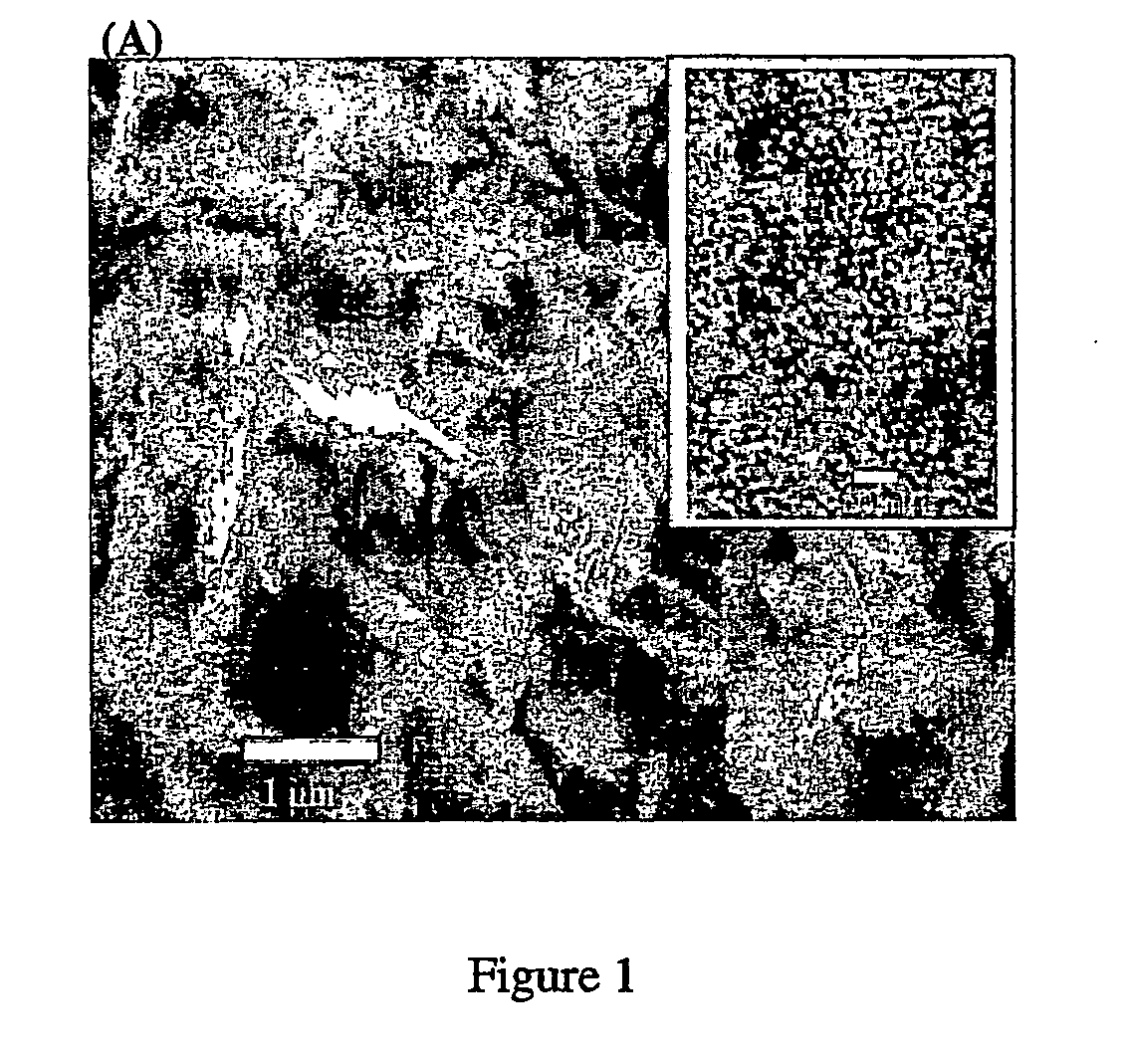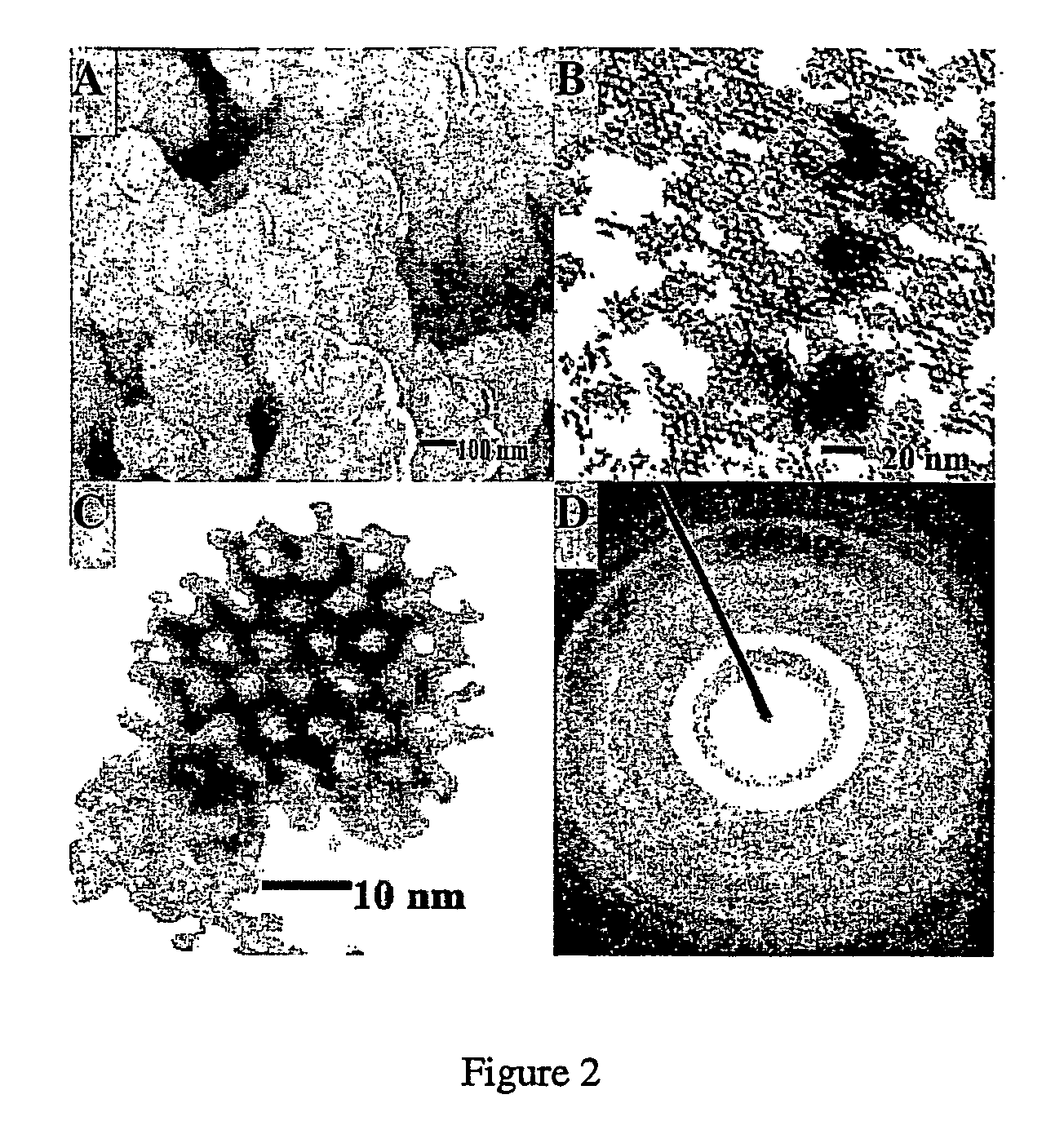Nanoporous/mesoporous palladium catalyst
a palladium catalyst and nanoporous technology, applied in the field of catalytic systems, can solve the problems of requiring 300 mv extra overpotential to function, exceedingly poor performance of platinum catalyst containing palladium based on current production methods, and not being considered suitable for use as an electrocatalyst in fuel cells or sensors
- Summary
- Abstract
- Description
- Claims
- Application Information
AI Technical Summary
Problems solved by technology
Method used
Image
Examples
example 1
Electrochemical Reduction Method Utilising a Non-Ionic Surfactant that Forms a Liquid Crystalline Phase to Prepare Mesoporous Palladium
[0091]The electroplating mixture consists of 12 wt % (NH4)2PdCl4, 47 wt % octaethylene glycol monohexadecyl ether (C16EO8), 2 wt % heptane and 39 wt % deionized water. The mixture was subjected to three heating-cooling cycles (temperature limits 20 and 80° C.) with vigorous shaking using a vortex mixer until a homogeneous mixture was formed. The mixture was then allowed to stand at room temperature overnight. A conventional three-electrode system utilizing a large-area platinum counterelectrode together with a saturated silver / silver chloride (Ag / AgCl) was used to perform the electrodeposition. Mesoporous palladium films were produced by electrochemical deposition from the electroplating mixture at +0.16 V vs Ag / AgCl onto a gold film. The thickness of the palladium films were controlled by recording the total charge passed during deposition. Typical ...
example 2
Electrochemical Reduction Method Utilising a Non-Ionic Surfactant that Forms a Liquid Crystalline Phase to Prepare Mesoporous Pd63Pt37 Alloy
[0093]Mesoporous Pd63Pt37 alloy material was electroplated from a mixture consisting of 12 wt % Na2PdCl6, 14 wt % H2PtCl6, 26 wt % H2O, 2 wt % heptane, 47 wt % surfactant C16EO8. The mixture was subjected to three heating-cooling cycles (temperature limits 20 and 80° C.) with vigorous shaking using a vortex mixer until a homogeneous mixture was formed. The mixture was then allowed to stand at room temperature overnight. A conventional three-electrode system utilizing a large-area platinum counterelectrode together with a saturated silver / silver chloride (Ag / AgCl) was used to perform the electrodeposition. The Palladium alloy mesoporous film was deposited onto a gold film at a potential of 0.06 V vs Ag / AgCl. Following deposition, the film was rinsed repeatedly in acetone and deionized water to remove impurities (surfactant, electrolyte and organi...
example 3
Chemical Reduction Method Utilising a Non-Ionic Surfactant that Forms a Liquid Crystalline Phase to Produce Mesoporous PtPdRuOs Alloy
[0094]A mixture containing 0.364 g Na2PdCl6 (Aldrich), 0.50 g H2PtCl6.xH2O (Aldrich), 0.202 g RuCl3.xH2O (Aldrich), 0.30 g Na2OsCl6.xH2O (Aldrich), 1.265 g Water, 1.88 g octaethylene glycol monohexadecyl ether non-ionic surfactant (C16EO8, Fluka) was homogeneously mixed with vigorous shaking using a vortex mixer and subjected to three heating-cooling cycles (temperature limits 20 and 80° C.) before being allowed to stand at room temperature for 12 hours. The quaternary catalyst was then precipitated by adding pieces of metallic Zn(Aldrich) to the reactant mixture to chemically reduce the metal salts present in the aqueous domains of the mixture. This reduction process was allowed to continue at room temperature until the mixture became fully black. The black deposit was washed successively with acetone, hydrochloric acid, water and acetone. The recover...
PUM
| Property | Measurement | Unit |
|---|---|---|
| thick | aaaaa | aaaaa |
| diameters | aaaaa | aaaaa |
| diameter | aaaaa | aaaaa |
Abstract
Description
Claims
Application Information
 Login to View More
Login to View More - R&D
- Intellectual Property
- Life Sciences
- Materials
- Tech Scout
- Unparalleled Data Quality
- Higher Quality Content
- 60% Fewer Hallucinations
Browse by: Latest US Patents, China's latest patents, Technical Efficacy Thesaurus, Application Domain, Technology Topic, Popular Technical Reports.
© 2025 PatSnap. All rights reserved.Legal|Privacy policy|Modern Slavery Act Transparency Statement|Sitemap|About US| Contact US: help@patsnap.com



